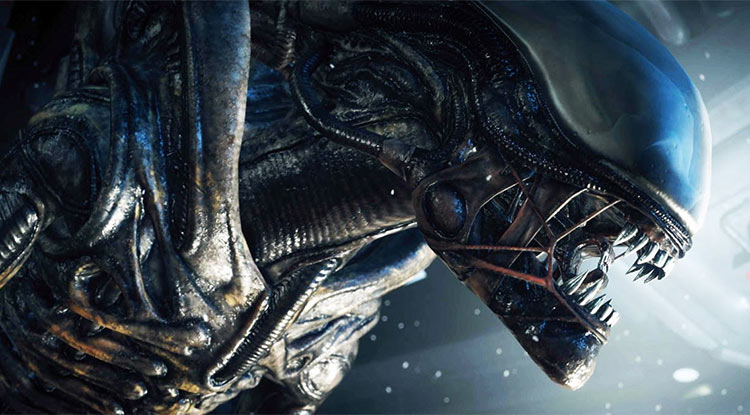Buy the H.P. Lovecraft complete collection.
Alien directly lifts from Lovecraft, both in story and technique. O’Bannon freely admitted to using H.P. Lovecraft’s writing as a source of inspiration while collaborating with co-writer Ronald Shusett on the film’s screenplay. Lovecraft’s fiction was to 20th century literature what science fiction cinema was to 1950s audiences: cheap, pulpy, overwritten, and devoted to only a niche group of genre fans. While Lovecraft churned out a collection of short fiction that was misunderstood in its time, his writings went on to influence horror fiction to such a degree that it has only been surpassed by Lovecraft’s own biggest influence, Edgar Allen Poe.
Part of Lovecraft’s appeal lay in his knack for crafting world-building mythology. As his writing grew, Lovecraft’s short stories synced up to form the “Cthulhu Mythos,” a premise that tended to show up in the majority of his fiction. The mythos conceit, originating in the seminal short story “Call of Cthulhu,” dictated that humanity inherited the Earth from warring extraterrestrial gods with names like Cthulhu, Yog-Sothoth, and Nyarlathotep. These entities were banished to an alternate dimension where they await the opportunity to return and seize control of our tiny planet. Their feelings toward the human race range from apathy to utter malice. Meanwhile, several pockets of cults (often subhuman descendants of these unimaginable beings) around the globe intend on conjuring them into our world and heralding Armageddon, often to mixed results.
Buy Tales of the Cthulhu Mythos.
Unlike many writers of weird fiction, Lovecraft encouraged his friends and fans to write and build upon the seed of this idea. Writers like Robert Bloch, Robert E. Howard, Clark Ashton Smith, and Fritz Leiber took the ideas and ran with them, adding to, altering, and celebrating the “Cthulhu Mythos.” This gave birth to an entire subgenre of horror fiction belonging exclusively to Lovecraftian writing, with such famous names as Neil Gaiman, Mike Mignola, Peter Straub, and Stephen King taking the imaginative formula and running with it to spectacular success.
By now, the literary trend has grown into a veritable multimedia movement. While American International Pictures took a crack at adapting Lovecraft’s short stories in the ’60s and ’70s to varying degrees of success, true Lovecraftian cinema wouldn’t arrive until Alien, where writers Dan O’Bannon and Ronald Shusett took the ideas of the mythos and turned them into a very different kind of monster movie. “Alien was certainly my most successful venture into Lovecraft turf,” O’Bannon said in an interview from Lurker In The Lobby: A Guide To The Cinema of H.P. Lovecraft. “Some Canadian reviewer said it best when he wrote, ‘Alien went to the home planet of the Old Ones.’ That describes it beautifully.”

The Nostromo approaching LV-426
Lurker, which I can easily recommend as one of the finest H.P. Lovecraft reference books out there, suggests the Xenomorph-ridden planet LV-426 is a world akin to Yuggoth, a home world to Lovecraft’s Elder Gods. Lovecraft describes Yuggoth as “a strange dark orb at the very rim of our solar system,” much like the perpetually stormy, nighttime world of Alien, “The sun shines there no brighter than a star, but the beings need no light. They have other subtler senses, and put no windows in their great houses and temples…”

H.R. Giger’s concept art for the initial home of Star Beast.
Xenomorph eggs in the temple of doom…









Stay Connected